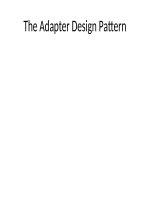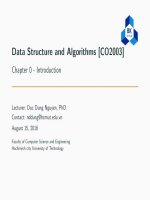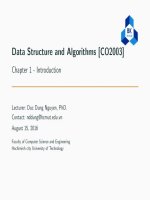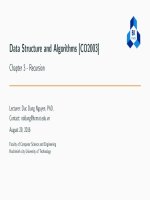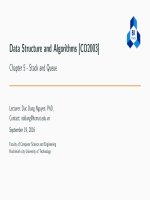C++ programming program design including data structure 7th ch06
Bạn đang xem bản rút gọn của tài liệu. Xem và tải ngay bản đầy đủ của tài liệu tại đây (386.5 KB, 51 trang )
Chapter 6:
User-Defined Functions
Objectives
In this chapter, you will:
–
–
–
–
Learn about standard (predefined) functions
Learn about user-defined functions
Examine value-returning functions
Explore how to construct and use a value-returning,
user-defined function
– Learn about function prototypes
– Learn how to construct and use void functions
C++ Programming: Program Design Including Data Structures, Seventh Edition
2
Objectives (cont’d.)
– Discover the difference between value and reference
parameters
– Explore reference parameters and value-returning
functions
– Learn about the scope of an identifier
– Examine the difference between local and global
identifiers
– Discover static variables
C++ Programming: Program Design Including Data Structures, Seventh Edition
3
Objectives (cont’d.)
– Learn how to debug programs using drivers and stubs
– Learn function overloading
– Explore functions with default parameters
C++ Programming: Program Design Including Data Structures, Seventh Edition
4
Introduction
• Functions are often called modules
• They are like miniature programs that can be
combined to form larger programs
• They allow complicated programs to be divided
into manageable pieces
C++ Programming: Program Design Including Data Structures, Seventh Edition
5
Predefined Functions
• In C++, a function is similar to that of a function in
algebra
– It has a name
– It does some computation
• Some of the predefined mathematical functions are:
sqrt(x)
pow(x, y)
floor(x)
C++ Programming: Program Design Including Data Structures, Seventh Edition
6
Predefined Functions (cont’d.)
• Predefined functions are organized into separate
libraries
– I/O functions are in iostream header
– Math functions are in cmath header
• To use predefined functions, you must include the
header file using an include statement
• See Table 6-1 in the text for some common
predefined functions
C++ Programming: Program Design Including Data Structures, Seventh Edition
7
User-Defined Functions
• Value-returning functions: have a return type
– Return a value of a specific data type using the return
statement
• Void functions: do not have a return type
– Do not use a return statement to return a value
C++ Programming: Program Design Including Data Structures, Seventh Edition
8
Value-Returning Functions
• To use these functions, you must:
– Include the appropriate header file in your program using
the include statement
– Know the following items:
• Name of the function
• Number of parameters, if any
• Data type of each parameter
• Data type of the value returned: called the type of the
function
C++ Programming: Program Design Including Data Structures, Seventh Edition
9
Value-Returning Functions (cont’d.)
• Can use the value returned by a value-returning
function by:
– Saving it for further calculation
– Using it in some calculation
– Printing it
• A value-returning function is used in an assignment
or in an output statement
C++ Programming: Program Design Including Data Structures, Seventh Edition
10
Value-Returning Functions (cont’d.)
• Heading (or function header): first line of the
function
– Example: int abs(int number)
• Formal parameter: variable declared in the heading
– Example: number
• Actual parameter: variable or expression listed in a
call to a function
– Example: x = pow(u, v)
C++ Programming: Program Design Including Data Structures, Seventh Edition
11
Syntax: Value-Returning Function
• Syntax:
• functionType is also called the data type or
return type
C++ Programming: Program Design Including Data Structures, Seventh Edition
12
Syntax: Formal Parameter List
C++ Programming: Program Design Including Data Structures, Seventh Edition
13
Function Call
• Syntax to call a value-returning function:
C++ Programming: Program Design Including Data Structures, Seventh Edition
14
Syntax: Actual Parameter List
• Syntax of the actual parameter list:
• Formal parameter list can be empty:
• A call to a value-returning function with an empty
formal parameter list is:
C++ Programming: Program Design Including Data Structures, Seventh Edition
15
return Statement
• Function returns its value via the return statement
– It passes this value outside the function
C++ Programming: Program Design Including Data Structures, Seventh Edition
16
Syntax: return Statement
• Syntax:
• In C++, return is a reserved word
• When a return statement executes
– Function immediately terminates
– Control goes back to the caller
• When a return statement executes in the function
main, the program terminates
C++ Programming: Program Design Including Data Structures, Seventh Edition
17
Syntax: return Statement (cont’d.)
C++ Programming: Program Design Including Data Structures, Seventh Edition
18
Function Prototype
• Function prototype: function heading without the
body of the function
• Syntax:
• Not necessary to specify the variable name in the
parameter list
• Data type of each parameter must be specified
C++ Programming: Program Design Including Data Structures, Seventh Edition
19
Value-Returning Functions: Some
Peculiarities
C++ Programming: Program Design Including Data Structures, Seventh Edition
20
Value-Returning Functions: Some
Peculiarities (cont’d.)
C++ Programming: Program Design Including Data Structures, Seventh Edition
21
Flow of Compilation and Execution
• Execution always begins at the first statement in the
function main
• Other functions are executed only when called
• Function prototypes appear before any function
definition
– Compiler translates these first
• Compiler can then correctly translate a function call
C++ Programming: Program Design Including Data Structures, Seventh Edition
22
Flow of Compilation and Execution
(cont’d.)
• Function call transfers control to the first
statement in the body of the called function
• When the end of a called function is executed,
control is passed back to the point immediately
following the function call
– Function’s returned value replaces the function call
statement
C++ Programming: Program Design Including Data Structures, Seventh Edition
23
Void Functions
• User-defined void functions can be placed either
before or after the function main
• If user-defined void functions are placed after the
function main
– The function prototype must be placed before the function
main
• Void function does not have a return type
– return statement without any value is typically used to
exit the function early
C++ Programming: Program Design Including Data Structures, Seventh Edition
24
Void Functions (cont’d.)
• Formal parameters are optional
• A call to a void function is a stand-alone statement
• Void function definition syntax:
C++ Programming: Program Design Including Data Structures, Seventh Edition
25

